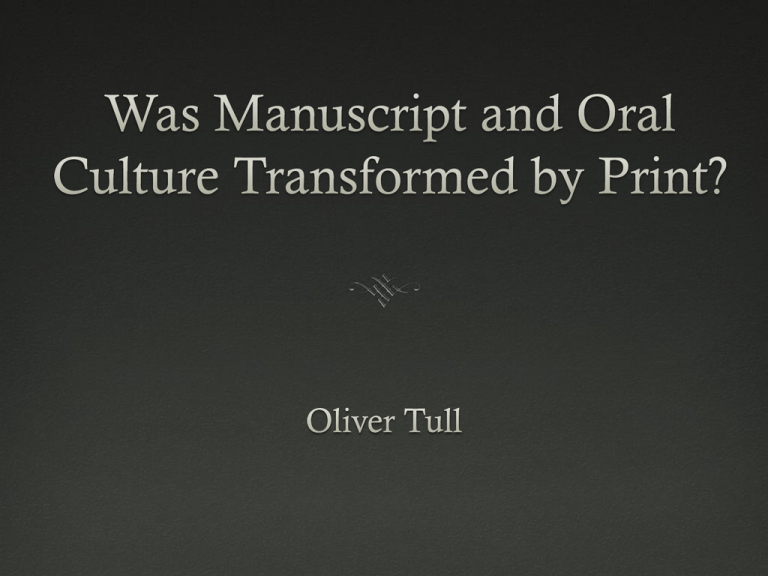Document 12793456
advertisement

Structure Background to Print Revolution Historiography: Print Revolution and examples Epistemology Political Communities Example: printed Sermons Historiography: Limitations of Print and Illustrative Examples Example 1: Rapes of Lucina Example 2: Catholic Martyrology Example 3: Ballad of Chevy Chase Background Not purely oral culture for years – manuscript key to all aspects of economic, social and cultural life But amount of written material change rapidly after 1440 invention of printing press: 46 titles a year published in 1500 259 in 1600 By mid-century could have 2000 titles appearing Historiography ‘Print Revolution’ Elizabeth Eisenstein saw print as catalytic to the spread of ideas for religious reformation and modern science Alvin Gouldner saw as key to the ‘democratization of writing’ Emphasis on print medium displacing older traditions New Epistemology Oral culture relied on memory. Memorise whole books Shakespeare sonnet 122 New Epistemology Idea of knowledge lying in books – standardised and readily available Print meant preservation and acknowledgement for all time – 1611 King James Authorized Bible translated anachronistically Job 19.23 ‘oh that my words were now written! Oh that they were printed in a boke’ Political Discourse Increased print volumes not just reflects period’s political division Example of print community with the Levellers Paliament responded with its own propaganda Hired professional polemicists like John Milton – see ‘the hunting of the Leveller’ by Jason Peacey Example of Printed Sermons Oral communication came to be affected by print In 1580s-90s preachers concerned about printing their sermons When printed sermons took off they fed back into oral culture by giving more material for preachers to draw on – see John Wilkin’s Ecclesiastes as a bibliography of other sermons and commentaries of the bible Gave common model for preachers to use Historiography: Limitations of Print Main criticism of Eisenstein’s thesis is that other forms of communication remained strong Already spoken in lecture about problem of illiteracy and role in New World colonies Harold Love and Arthur Marotti Adam Fox ‘Oral and Literate Culture in England’ Oral and scribal communication both served purposes that print could not supplant Example 1: Rapes of Lucina Harold Love note Earl of Rochester’s adaption of popular classical tale 1675 print version meant much more for readers than viewers – more metaphorical language Also circulated manuscript version to narrow personal network – much more controversial and included open discussion of homosexuality When transferred on to the stage, eunuch that Valentinian exchanges ‘moist kisses’ with is removed Example 2: Catholic Martyrology Arthur Marotti’s study shows how manuscript culture hugely important to persecuted Catholic community Presses censored Lent itself to being spread secretively around family and Catholic circles Example 3 – Ballad of Chevy Chase Most popular English ballad of the period – adapted to print first in 16th C Printed copies set above fireplaces or posted on alehouse walls Fed Back into oral culture: Talk about ‘lend me your ear’ beginnings Copied up for personal enjoyment by a Lancashire gentleman in his own personal folio mid-century Hence Fox said it is hard to determine whether the ballad was ‘a product of oral, scribal or print culture’ Overview Print culture hugely influential on both scribal and oral cultures But did not replace these – coexisted with them These different cultures served different purposes within society